Report

Executive summary
This is the ninth consecutive year that we have tracked the shopping behaviors of Chinese consumers. Our continuing research has given us a valuable long-term view across 106 fast-moving consumer goods (FMCG) categories purchased for home consumption in China. As in each of the past eight years, we analyzed the key 26 categories1 that span the four largest consumer goods sectors: packaged food, beverages, personal care and home care. We also looked at another 19 categories2 to form a more comprehensive view of the market. Combined, these sectors represent 80% of all FMCG.
As we endure historic times introduced by the Covid-19 pandemic, this year’s report includes a deep look at the changing consumer behavior resulting from the pandemic in the first months of 2020 and the implications for consumer goods companies and retailers during an uncertain recovery.
Written in collaboration with
Written in collaboration with

It is official: FMCG growth is stable
First, it is important to look at the stage that was set for Covid-19. After many years of aggressive value growth followed by two straight years of slower but consistent 5.2% growth, China’s overall FMCG growth of 5.5% in 2019 represented stabilization. Growth seemed to hit a sweet spot.
This steady growth masks a continuation of the distinct two-speed growth trajectories taken by different category sectors. In a pattern we first identified four years ago, the food and beverage sectors and the personal care and home care sectors are expanding at vastly different speeds.
In 2019, packaged foods value rose by 1.9%, a drop from 4.5% a year earlier, mostly due to declining growth in average selling prices. Beverages grew by 2.9%, an increase from 1.6% in 2018. In line with the two-speed pattern, personal and home care categories grew at a much faster pace. Personal care categories achieved 11.8% value growth, while home care registered 9.4% growth—setting records for both sectors. Those value gains resulted mainly from a significant boost in volume growth that more than offset a deceleration in average selling price (ASP) increases.
Two-speed growth shows up most clearly in a few important areas. Products associated with healthier lifestyles grew particularly fast. For example, increasing hygiene awareness led to 5% volume gains and 13% ASP increases in compound annual growth for disinfectants from 2017 to 2019. On the other hand, sales declined for products perceived as being unhealthy and fattening.

Macro Surveillance Platform
For more detail on the business implications of coronavirus from Bain’s Macro Trends Group, log on to the Macro Surveillance Platform. Learn more about the platform >
A rebound in volume and slowdown in premiumization
In addition to the two-speed dynamic among categories, we saw volume and prices moving in different directions. Overall FMCG volume grew 2.0%, a sizeable leap from 0.7% in 2018. However, ASP growth dropped to 3.4% from 4.5%, signaling that FMCG companies could not depend on premiumization as much as they did in previous years. We define premiumization as the ability to increase ASP above the rate of inflation, which was 2.9% in China in 2019.
In many consumer goods categories, a lower-priced value/mass segment is rising in tandem with premium categories. This polarization trend began in 2019 and, as we explain later, accelerated in the early months of the Covid-19 pandemic, when many worried Chinese consumers shifted to value products. The emergence of value/mass products has led to slower price growth or even price declines in some categories.
Channel changes: Online boosted by O2O and livestreaming
Once again, online channels continued to gain fans. E-commerce grew by 35.2% in 2019, gaining share from hypermarkets, which declined by 3.4%, while grocery further declined by 7.2% due to the rise of modern trade and online-to-offline (O2O) retailing. Convenience is a big reason for the shift to online retailing in China. That thirst for convenience is reflected in the widespread adoption of O2O, which now represents 4.3% of total FMCG value share and is playing an increasing role in sustaining offline channels. This is the promise of New Retail, with physical stores teaming with online retailers, forming ecosystems that blur the lines between online and offline.
But the big story in online retailing in 2019 is the spectacular rise of livestreaming in China. The year 2019 will be remembered for the explosion of short, engaging personal videos that serve as a sales channel for everything from lipstick to instant noodles. Livestreaming provides immersive experiences, personalized recommendations and, as the country locked down during the Covid-19 pandemic, an entertaining alternative to physical shopping trips. Virtually nonexistent three years ago, livestreaming sales more than tripled in 2019 and account for 4% of total retail sales (not only FMCG) and about 1% of total retail sales. But livestreaming brings with it a challenge in that many of the products are sold on promotion, which reduces ASP.
In addition to livestreaming, the increasing number of online festivals and the steady shift to online also contributed to higher promotion rates for most categories in 2019. This is especially the case with personal care, home care and baby categories. Overall, online promotions grew from 40% to 43% in 2019. Meanwhile, offline promotions have increased, too—from 22% to 23%.
As in previous reports, we track online penetration by segmenting product categories into four clusters.
The first cluster consists of categories with relatively high online penetration and low penetration growth. Many of these categories—including diapers, infant formula, skin care, makeup and others—are approaching the limits of online penetration growth. With that plateau in plain sight, some companies are now moving to omnichannel strategies.
The second and third clusters, spanning categories such as paper products, fabric detergent, chocolate and biscuits, are steadily growing online penetration, principally through premiumization that can offset delivery costs.
The fourth cluster is comprised of impulse categories such as chewing gum, candy and beverages. For these categories, the high cost of fulfillment limits the potential for achieving major online penetration gains.
Foreign brands start to win in China
For each of the past nine years, we have reported on the intense competition between foreign and domestic brands. This year marks a turning point. For the first time, foreign companies outpaced their domestic counterparts. Foreign FMCG companies grew 9.5% in 2019, compared with Chinese company growth of 7%. Some of the gains have been quite dramatic. L’Oréal grew sales by 35% in 2019.
This change has been steadily gaining momentum. Indeed, in each of the past three years, foreign companies have learned how to win in China by taking what we call a “4D” approach: design for China, decide in China, deliver at China speed and digitalize the China business. (See the Bain Brief “Consumer Products: Now’s the Time to Double Down on China.”) Foreign brands also rely on premiumization to outperform Chinese companies.
Our analysis also compares the performance of brands based on their size. In last year’s report, China Shopper Report 2019, Vol. 1: Premium Products, Small Brands and New Retail, we described how established brands feared the mounting competition from small insurgents. While trusted, established brands withstood Covid-19 relatively well, the top 20 brands continued to lose share to smaller brands in most categories in 2019.
Covid-19’s impact: Why some categories keep booming
The crisis that has dealt such a serious blow to people and businesses has altered consumer behavior in China virtually overnight. As the nation endured lockdowns, quarantines and then a tentative recovery, consumers quickly adapted their spending patterns.
First and foremost, consumers spent less. Total retail sales in the first quarter of 2020 fell by 19% from a year earlier, the biggest decline on record. Overall FMCG spending dropped by 6.7%. Within FMCG, food and beverage spending fell by 7.7% and nonfood and beverage spending fell 4.6%.
Health- and hygiene-related categories boomed and continue to boom, while nonnecessary and impulse-driven categories were hit hard during the outbreak and are recovering slowly. Top brands and Chinese brands suffered less as consumers showed a preference for trusted and locally relevant brands.
Two other important consequences: the pandemic hastened the flight to value brands that we identified in 2019 and accelerated the shift to online channels. Stuck at home, consumers had no choice but to buy online—and many opted to stick with online purchases even after stores opened. This was particularly true for grocery sales. Overall, online channels enjoyed healthy 19% year-over-year growth in the first quarter of 2020, during the Covid-19 pandemic, while offline sales dropped by 13%.
Covid-19 affected FMCG companies in four distinct ways. A first group of product categories boomed during the pandemic and continued booming in the recovery. This is the growth trajectory of hygiene categories such as personal wash and categories that were widely used in stay-at-home situations. More people were cooking at home, so soy sauce sales took off. When restrictions eased, consumers renewed their commitment to health and their desire to pursue homebound activities. As a result, sales of these products remained strong.
A second group of categories boomed during the lockdown, then stabilized. This was the case with frozen food, packaged water and household cleanser. Consumers had stocked up for the pandemic and had enough on hand after it ended. A third group endured a V-shaped recovery. For example, sales of beer, skin care and pet food dropped dramatically during the pandemic, only to recover quickly, as consumers felt the need to repurchase them. A final pattern: categories such as makeup, which is less important when wearing masks, and impulse categories like candy declined, but are likely to improve slowly in an L- or U-shaped recovery.
Now, the road ahead is lined with obstacles as the country faces geopolitical risks, heightened unemployment, high levels of government debt and inflationary pressure. Amid so much uncertainty, economists vary widely in their predictions for the future, with some anticipating a year or more for the economy to recover fully.
We are at a pivotal moment when leadership teams need to devote time to planning for recovery and retooling. As brands and retailers brace for whatever lies ahead, their retooling will require corporate transformation as well as a renewed dedication to consumer understanding.
Implications for brands and retailers
As they look to the future, brands can retool by closely monitoring consumer spending after Covid-19. They can adapt their portfolios accordingly by delivering products that are newly relevant, covering both premium and value segments. They also should invest to win in growing channels, particularly online, O2O and livestreaming. Building trust with local consumers, even during uncertain times, means taking the 4D approach: design for China, decide in China, deliver at China speed and digitalize the China business.
The post-Covid world requires retailers to stay closer than ever to consumer trends and to focus operations on the areas that will matter the most. As consumers embrace health and wellness, it is more important than ever to win with fresh offerings. Retailers also need to accelerate e-commerce channels and thoughtfully curate product assortments, focusing on productive items and new items that will be in high demand after the pandemic has passed. Improving operations will require changes to facilitate flexible fulfillment while reducing complexity, developing real-time response capabilities and making omnichannel profitable to balance the O2O business.
Full report
Fast-moving consumer goods growth stabilizes
After years of supercharged value growth in China followed by two straight years of 5.2% growth, China’s overall FMCG growth of 5.5% in 2019 represented stabilization. But there was a continuation of the two-speed growth trajectories. In a pattern we first identified four years ago, the food and beverage sectors are expanding at a vastly different speed from the personal care and home care sectors.
In 2019, beverages grew by 2.9%, an increase from 1.6% in 2018 (see Figure 1). The improved performance results from growing sales of large pack sizes combined with product innovation. For example, premiumization helped the beer category overcome volume dips, with the popularity of craft beer and imported beer delivering the price gains.


Innovation enabled carbonated soft drinks to not only raise prices, but further cannibalize sales of ready-to-drink tea. Milk benefited from premiumization, too—in both fresh and ambient (which does not require chilling) milk. However, a lack of innovation led yogurt to lose volume. Another factor: families with kids viewed ambient yogurt drinks as being less nutritious and healthy. On the other hand, increased awareness of health and wellness helped grow the packaged water category’s market; value grew 7.2% vs. 6.7% in 2018.
Packaged foods grew by 1.9%, a drop from 4.5% a year earlier, mostly due to declining growth in average selling prices. There were some notable patterns in packaged food sales. Instant noodles and infant formula still led the pack. Instant noodles grew 6%, propelled by large pack sizes and consumers’ unending desire for convenience. And while infant formula remains a strong category, it lost some ground due to the decreasing birth rate, which resulted in slower volume growth and intensified competition, leading to lower prices. Meanwhile, impulse food categories such as candy and chewing gum continue to decline in value growth. In addition to a general reluctance to eat snacks that are perceived to be unhealthy, consumers are making fewer trips to the offline retail checkout counters where these items typically are purchased.
In line with the two-speed pattern, the personal and home care categories grew at a much faster pace than food and beverages. Personal care categories achieved 11.8% value growth, while home care grew 9.4%, setting records for both sectors. Those value gains are mainly due to a significant boost in volume growth that more than offset a deceleration in average selling price increases.
Indeed, volume growth boomed in personal care categories, gaining 4.2%, compared with 0.5% in 2018. Consider the situation with hair conditioner, which rebounded in 2019 as volume grew 8.4%, compared with a 0.8% decline the year earlier. Among the factors in the volume gains: more buyers entered the category as manufacturers educated consumers through advertisements for such products as Dove Dogma or Pantene Quench Intensive Shot Hair Mask.
Personal wash was another successful personal care category. Its sales grew 11.1% in value, compared with 7.7% a year earlier, mainly due to consumers switching from bars to higher-priced shower gel, which gained in penetration and consumption frequency. And the toothbrush category also performed well, growing 30% through premiumization as more people opted for electric toothbrushes to replace their traditional ones.
However, not all personal care categories flourished. For example, the value of diaper sales declined by 1.1%, compared with 9.6% growth in 2018, due to negative growth in both volume and ASP. What was behind the disappointing performance? A slowdown in demand caused by the slowing birth rate. Also, over the past three years, local brands have steadily taken share from foreign brands, leading to price competition.
In the home care sector, fabric softener continues to lead the growth. Fabric softener grew 12.7% in 2019, led primarily by such foreign brand innovations as Downy scent beads. Kitchen cleanser also had a strong year, growing 11.1%, compared with 5.8% the previous year, the result of robust growth in volume and ASP. Both facial tissue and toilet tissue achieved rapid volume growth—10.1% and 10.7%, respectively—due to stockpiling. Facial and toilet tissues significantly increased online penetration in 2019, although discounted stockpiling during online shopping festivals led to lower ASP.
The two-speed growth was obvious in areas related to health and nutrition. Products associated with healthier lifestyles grew particularly fast. Increasing hygiene awareness led to 5% volume gains and a 13% ASP jump in compound annual growth for disinfectants from 2017 to 2019. Leading brands like Walch and Dettol have made the most of this trend, promoting mild disinfectants that can be applied to furniture, apparel and skin products. On the other hand, products viewed as unhealthy and fattening lost ground.
A rebound in volume and slowdown in premiumization
The two-speed dynamic is evident in volume and prices (see Figure 2). Overall FMCG volume grew 2.0%, a sizable leap from 0.7% in 2018. However, ASP growth dropped to 3.4% from 4.5%, barely above the rate of inflation. This signals that FMCG companies could not depend on premiumization as much as in previous years. Indeed, only a handful of product categories are enjoying fast price growth, while most are experiencing slower price growth—or even price drops (see Figure 3).
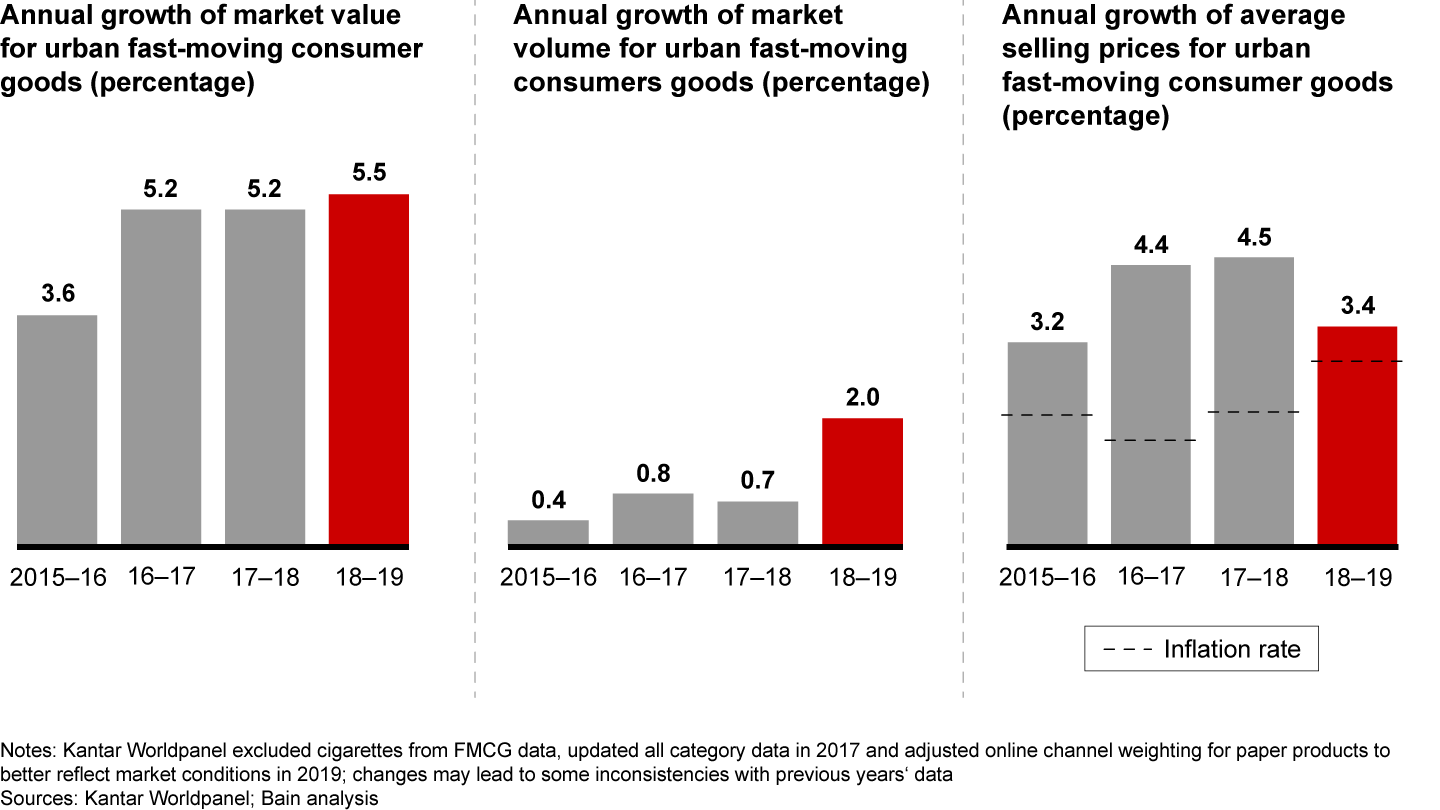

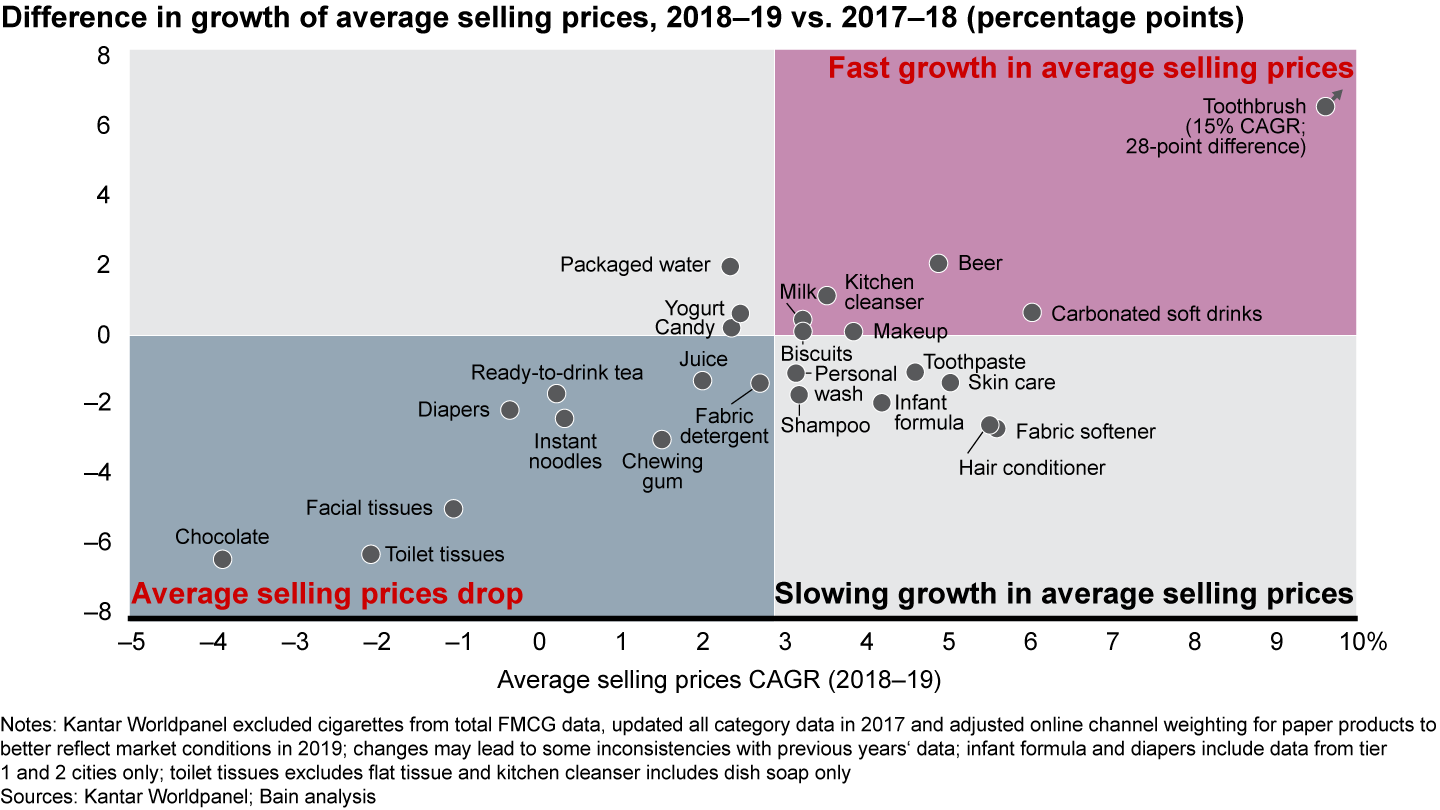

When evaluating premiumization, we divide categories into distinct groups. In some categories, companies are effectively delivering premiumization through innovation. For example, carbonated soft drink companies—traditional players and insurgents alike—have introduced new flavors in recent years that consumers have embraced, ranging from grapefruit to rum to salted caramel to coffee. Such innovations have helped deliver 12% ASP growth and 6% volume growth from 2017 to 2019, expanding the carbonated soft drink market by 19%.
Another set of categories includes facial tissues, chocolate, chewing gum and diapers. Average selling prices either slowed down or dropped. One of the reasons behind this pricing trap: companies aggressively used promotions, especially in online channels. In chocolates, for example, online ASP was 17% lower than the average ASP for all channels.
However, there is another reason that so many categories face falling ASP. Mass segments are growing as fast as premium segments, with both outpacing midrange segments (see Figure 4). On balance, that results in slower price growth or even price declines. This polarization trend began in 2019 and, as we explain later, accelerated in the early months of the Covid-19 pandemic, when many cautious Chinese consumers shifted to value products. The situation is most dramatic in toilet tissues, where the mass/value segment more than doubled the growth rate of the premium segment (28% vs. 12%), causing average prices to sink from 5% annual growth in 2018 to a 2% decline in 2019.
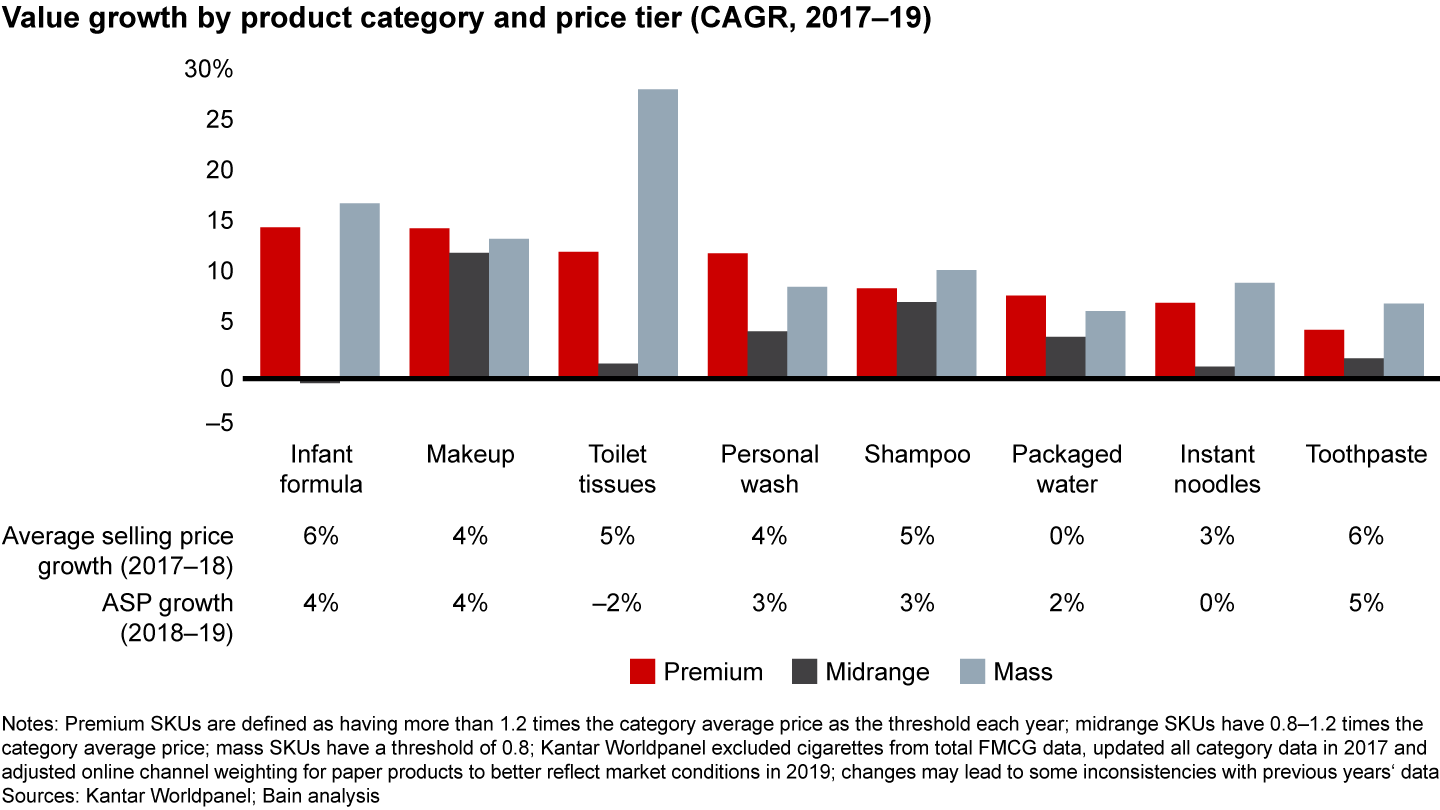

Channel changes: Online boosted by O2O and livestreaming
Once again, online channels continued to gain fans. E-commerce grew by 35.2% in 2019, gaining share from hypermarkets, which declined by 3.4%, while grocery further declined by 7.2% due to the rise of modern trade and O2O retailing (see Figure 5). Among offline channels, convenience stores performed best in 2019, with many now providing such new services as last-mile delivery for e-commerce.
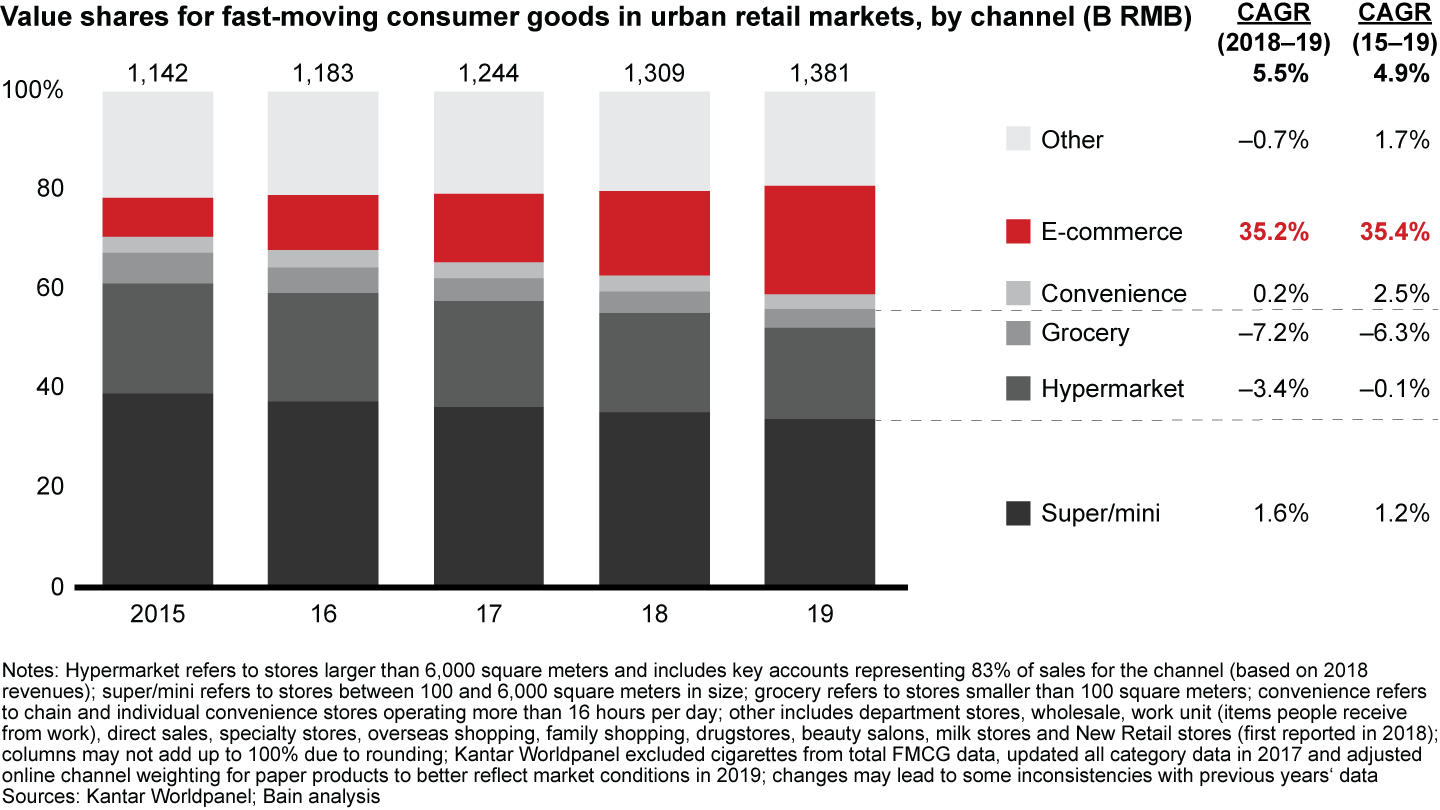

Convenience spurred the shift to online retailing. The pursuit of convenience is evident in the widespread adoption of O2O, which now represents 4.3% of total FMCG value share and is playing an increasing role in sustaining offline channels (see Figure 6). This is the promise of New Retail, with physical stores partnering with online retailers to form ecosystems that blur the lines between online and offline.
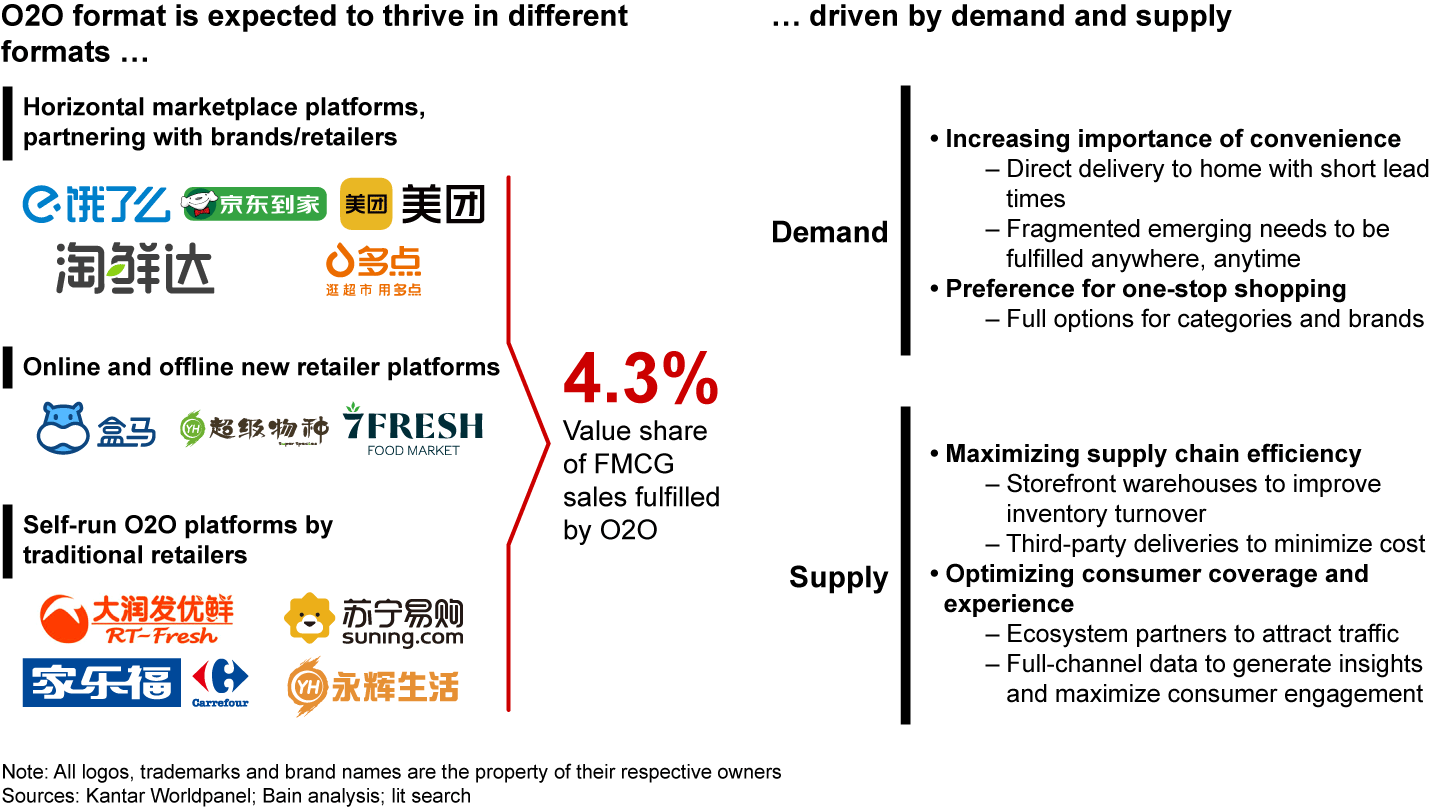

New retailers such as Alibaba’s Hema and JD’s 7Fresh enable a seamless online and offline shopping experience and provide delivery to homes near their offline outlets. Meanwhile, traditional retailers have shifted to online channels by launching their own mobile applications such as Yonghui Superstore’s Yonghui Life or RT-Mart’s RT-Fresh. And the rapid expansion of food delivery platforms such as Meituan or Ele.me, as well as O2O platforms launched by e-commerce players such as JD’s JD Daojia and Taobao’s Taoxianda, also contribute significantly to the rise of O2O retail.
Demand and supply factors keep O2O thriving. Consumers want anytime shopping and short-turnaround delivery. Brands want to make the most of efficient supply chains to serve both offline and online. They also want to build traffic via ecosystems partners and use full-channel data to generate valuable consumer insights and maximize consumer engagement.
As in previous reports, we tracked online penetration by segmenting product categories into four clusters (see Figure 7).
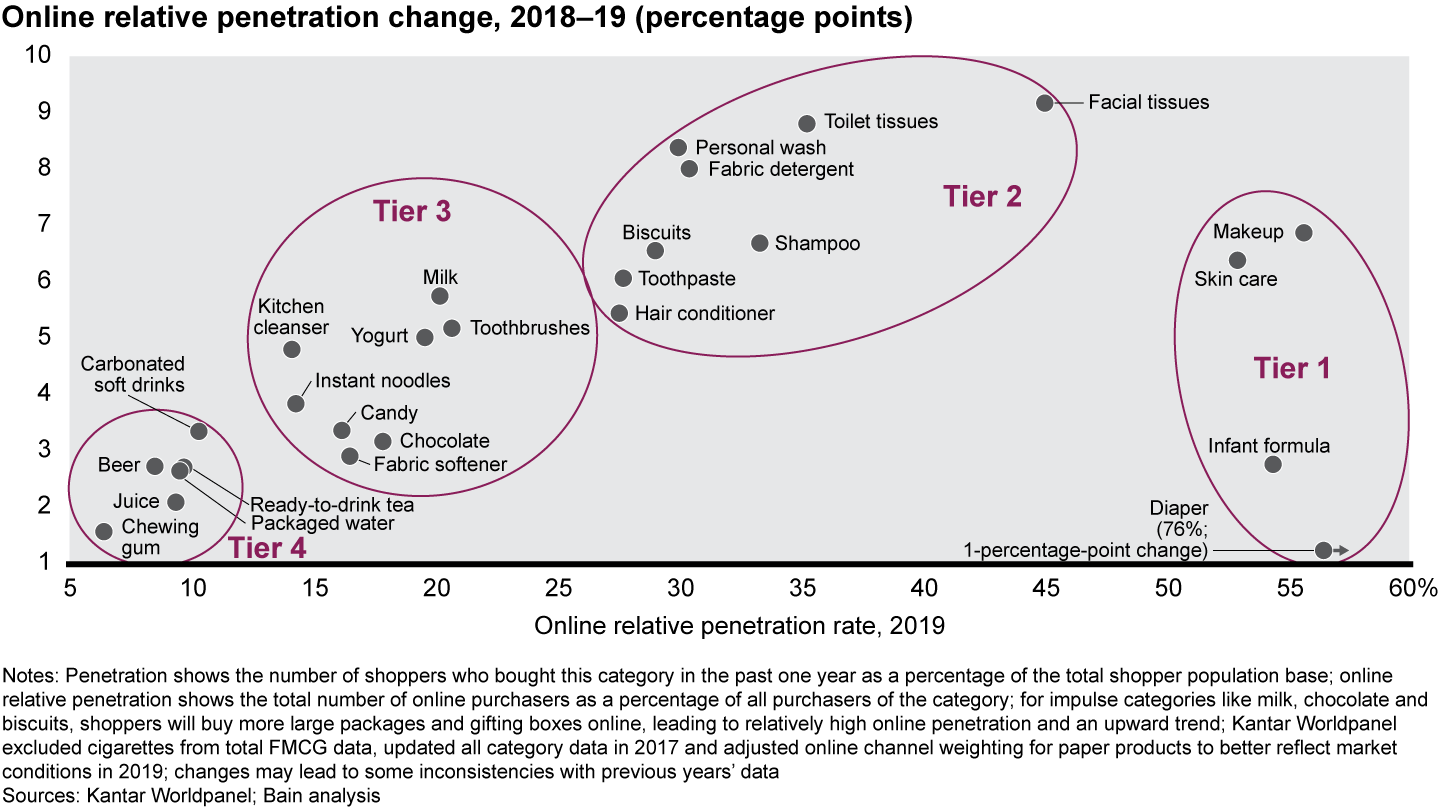

- The first cluster consists of categories with relatively high online penetration and low penetration growth. Many of these categories—including diapers, infant formula, skin care, makeup and others—are approaching the natural limits of online penetration growth. With that plateau in plain sight, many are now moving to omnichannel strategies. Among the reasons: the marginal cost of online customer acquisition increases with higher penetration. Also, omnichannel enables them to maximize offline stores, making the most of digitalized solutions and direct-to-consumer touchpoints.
- The second and third clusters, spanning categories such as paper products, fabric detergent, chocolate and biscuits, are steadily growing their online penetration, principally through premiumization that can offset delivery costs.
- The fourth cluster comprises impulse categories such as chewing gum, candy and beverages. For these categories, the high cost of fulfillment limits the potential for major online penetration gains mostly to their premium segments.
Online retailing in 2019 saw the dramatic rise of livestreaming in China. There was an explosion in the number of short, engaging personal videos that serve as a sales channel for everything from lipstick to instant noodles. Livestreaming provides immersive experiences, personalized recommendations and, as the country eventually locked down during the Covid-19 pandemic, an entertaining alternative to physical shopping trips. Virtually nonexistent three years ago, livestreaming sales on Taobao, Kuaishou, Douyin and a host of new platforms more than tripled in 2019, now accounting for 4% of total online retail sales (not only FMCG) and about 1% of total retail sales (see Figure 8).
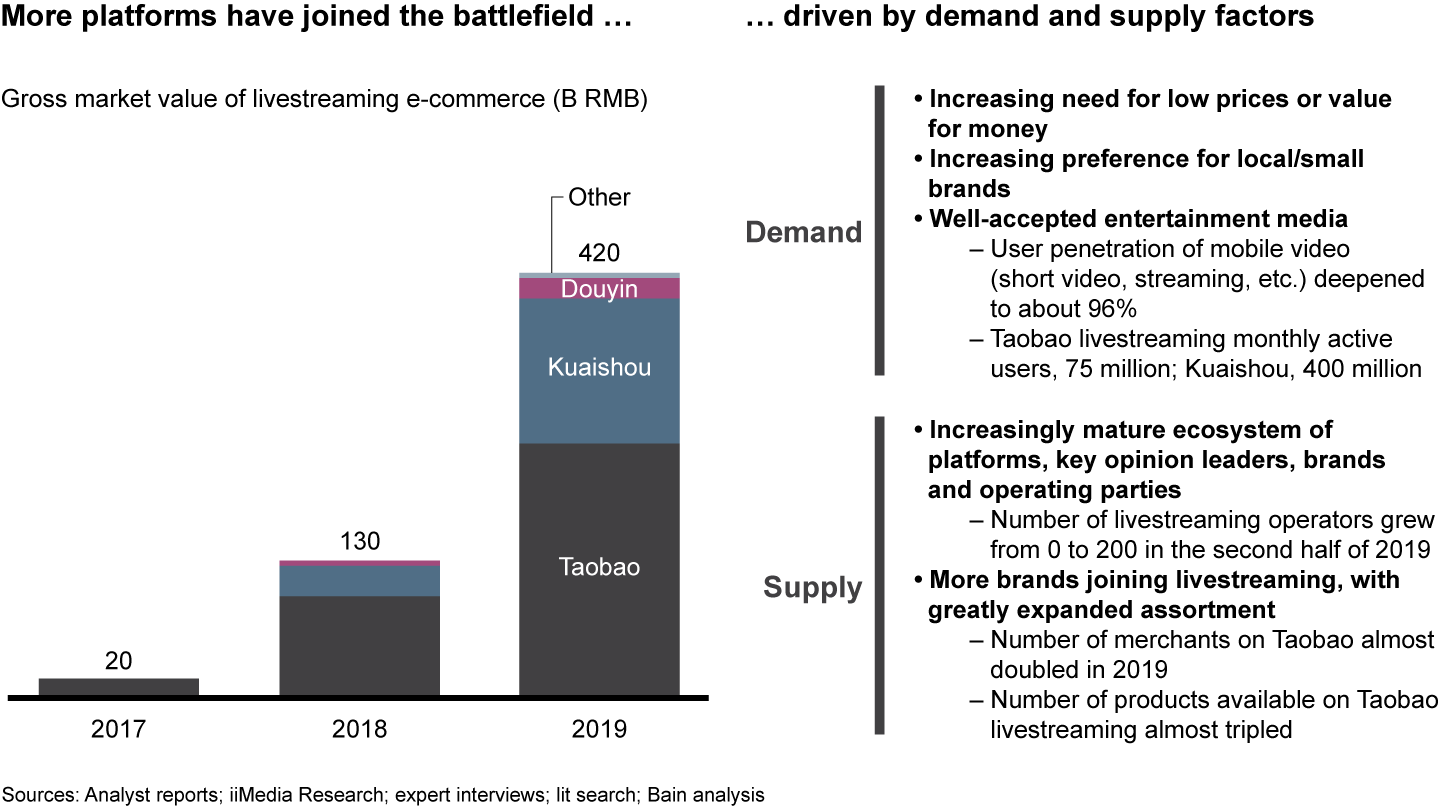

A number of factors make livestreaming the hottest retailing trend. It has a vast potential audience for mobile video—a huge market of consumers for the low-priced local products promoted on short videos. Combine that with the mature ecosystem of platforms, key opinion leaders (KOLs), brands and operating parties. The number of products promoted on Taobao via livestreaming nearly tripled in 2019—before the pandemic—and the number of Taobao livestreaming merchants almost doubled.
But livestreaming comes with a fundamental challenge: many of the products sell on promotion. For example, products on livestreams hosted by top KOLs like Li Jiaqi and Viya usually sell at a 30% to 60% discount to the Tmall price and sometimes lower than the Double 11 festival prices. While it has introduced a new way to purchase consumer goods and encourages impulse shopping, livestreaming also has influenced the overall rate of FMCG sold on promotion and, as a result, has depressed average selling prices.
Indeed, the emergence of livestreaming, combined with the increasing number of online festivals and the steady shift to online retail, resulted in higher promotion rates for most categories in 2019 (see Figure 9). This is especially the case with personal care categories like skin care, which saw promotions rise by 6.3 percentage points from 2017 to 2019. Promotions for diapers and infant milk formula increased by 4.8 and 5.1 points, respectively, over those two years. Overall, the online promotion rate grew from 40% to 43% in 2019. Offline promotions have increased, too—from 22% to 23%—but still are substantially less than online (see Figure 10).
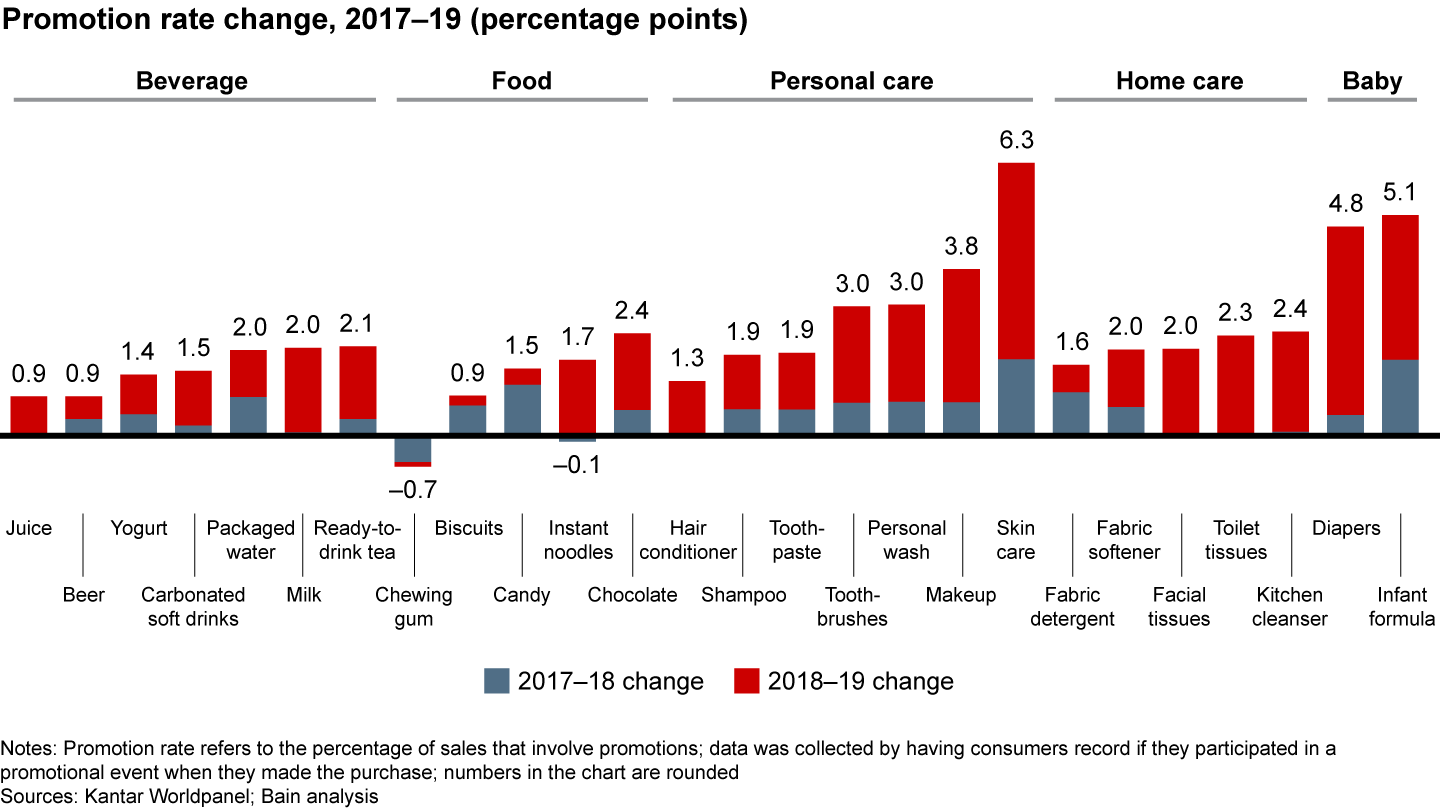

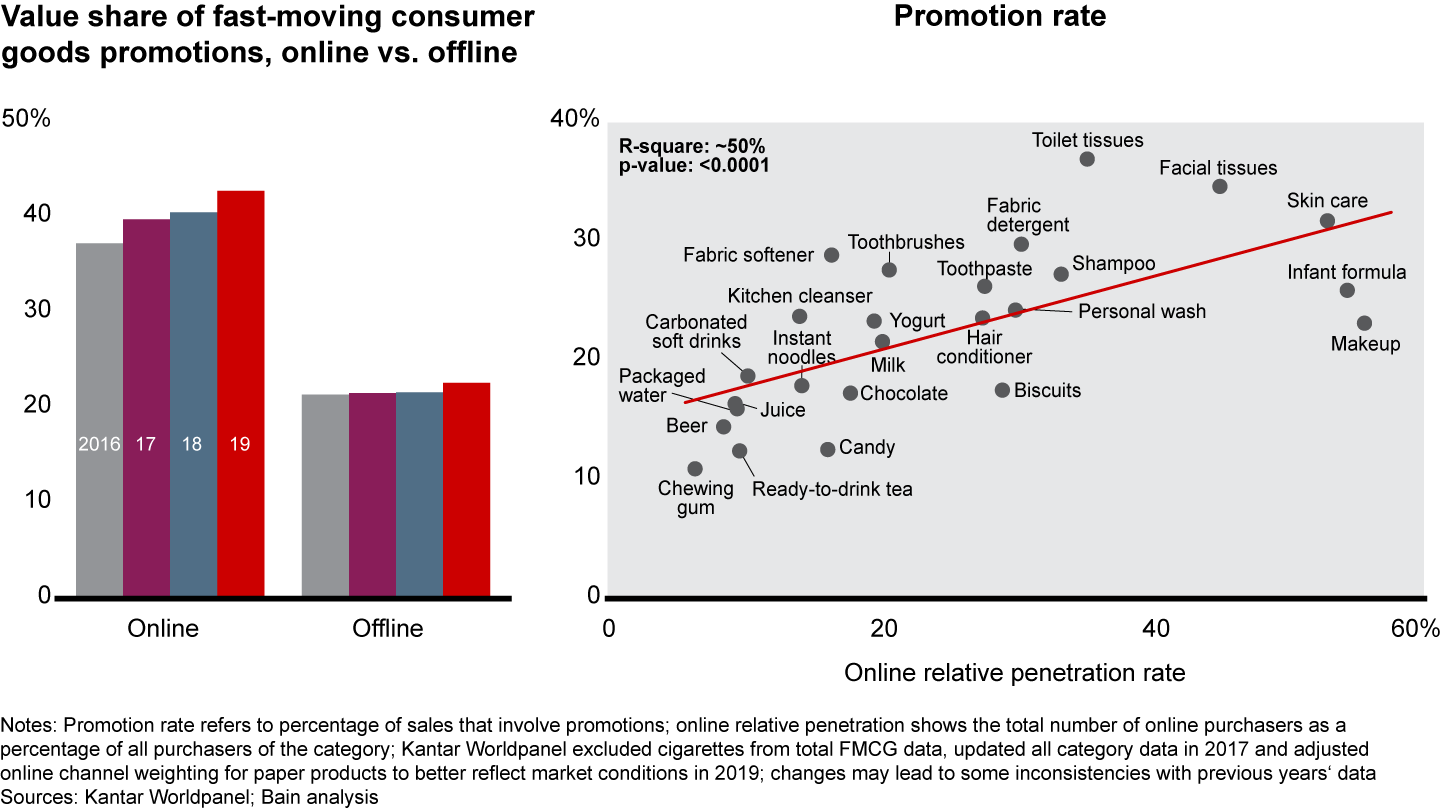

Foreign brands start to win in China
Our analysis compared the performance of brands based on their revenues. In last year’s report, China Shopper Report 2019, Vol. 1: Premium Products, Small Brands and New Retail, we described how established brands feared the mounting competition from small insurgents. In 2019, the top 20 brands continued to lose share to smaller “long-tail” brands in most categories (see Figure 11). There were notable exceptions, however. For example, top 5 brands gained share in kitchen cleanser, packaged water and makeup.
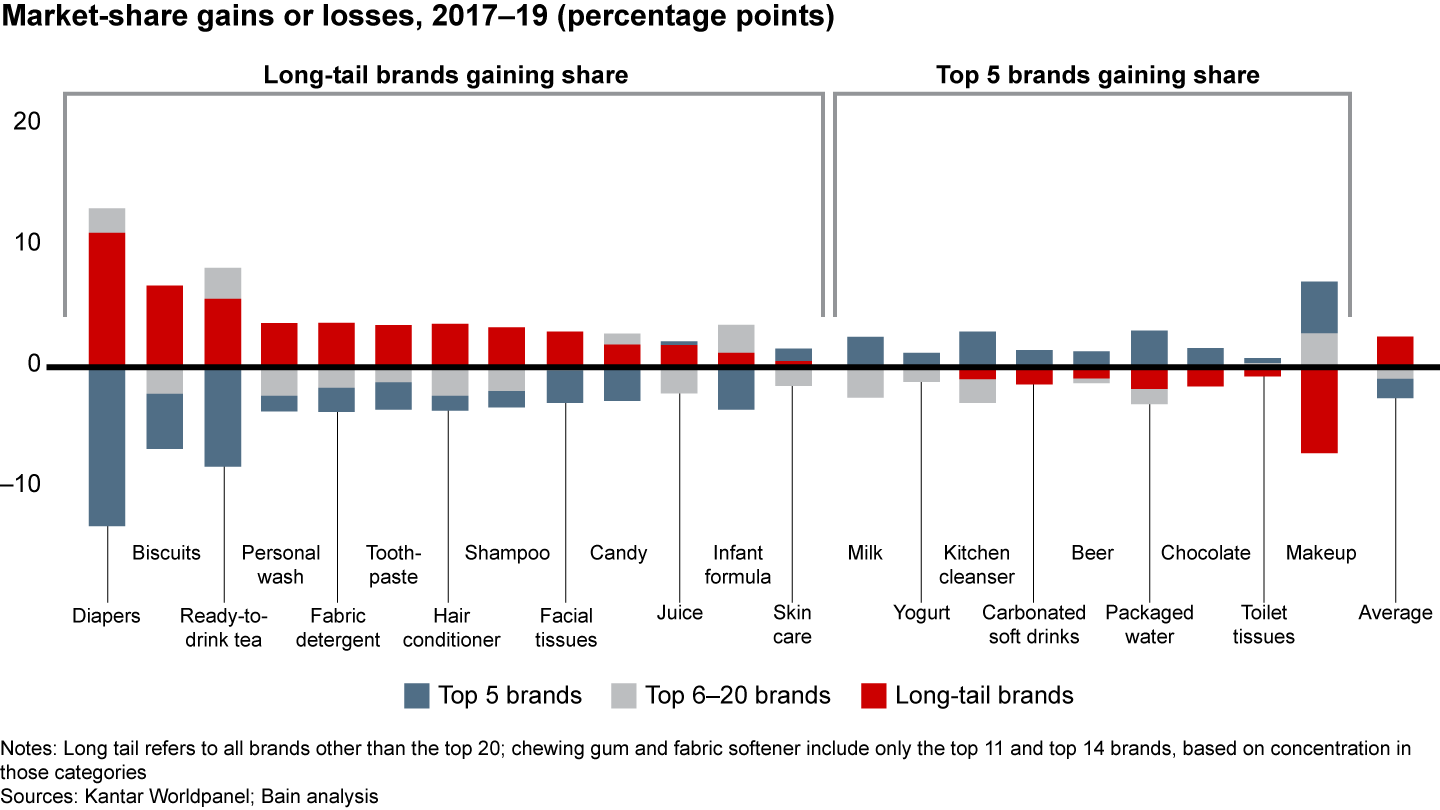

For each of the past nine years, we have reported on the intense competition between foreign and domestic brands. This year marks a turning point. For the first, time foreign companies outpaced their domestic counterparts (see Figure 12). Foreign FMCG companies grew 9.5% in 2019, compared with Chinese company growth of 7%. Some of the gains have been quite dramatic. L’Oreal grew sales by 35% in 2019.
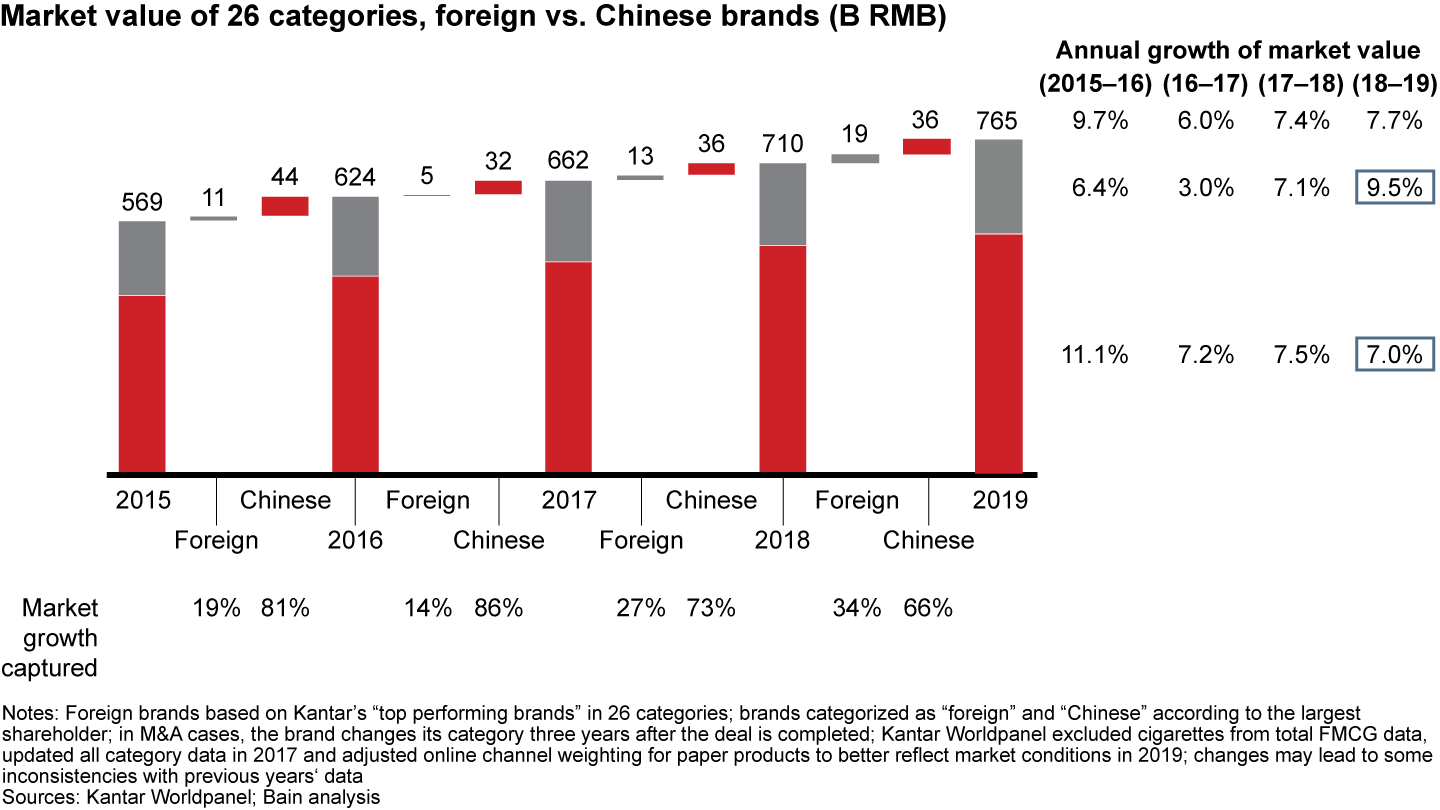

This change has been steadily gaining momentum. Indeed, in each of the past three years, the gap has narrowed to the point that in 2018, foreign multinational corporations’ growth of 7.1% was only slightly less than the 7.5% growth of Chinese companies. Premiumization is not the only factor that enables foreign brands to outperform Chinese companies. Foreign companies undoubtedly are learning how to win in China by taking the 4D approach: design for China, decide in China, deliver at China speed and digitalize the China business. (See the Bain Brief “Consumer Products: Now’s the Time to Double Down on China.”)
Foreign companies that sustain a strong presence in China are fluid enough to reinvent themselves as quickly and as often as needed. Millions of new Chinese consumers enter the market each year, essentially redefining demand. Winning brands are rigorous in tracking the trends and responding. One way is through micro-battles. They zero in on small, achievable initiatives that easily can be scaled.
Another way that leading foreign companies speed the pace of execution is by working with one of China’s powerhouses, Alibaba and Tencent, which can access much of the consumer transaction data in the country through their e-commerce and social commerce platforms. They also provide access to information from the many participants in their vast ecosystems that encompass social media, gaming and entertainment.
Covid-19’s impact: Why some categories keep booming
As the nation dealt with lockdowns, quarantines and a tentative recovery, consumers quickly adapted their spending patterns.
The economic toll has been well documented. China’s GDP dropped by 6.8% in the first quarter of 2020, with five million urban jobs lost in January and February, the hardest hit months (see Figure 13). Worried and weary consumers spent considerably less on FMCG. Total retail sales fell by 19% the first quarter of 2020, for the biggest decline on record. Overall FMCG spending dropped by 6.7%. Within FMCG, food and beverage spending fell 7.7%, and non-food and beverage spending fell 4.6% (see Figure 14).
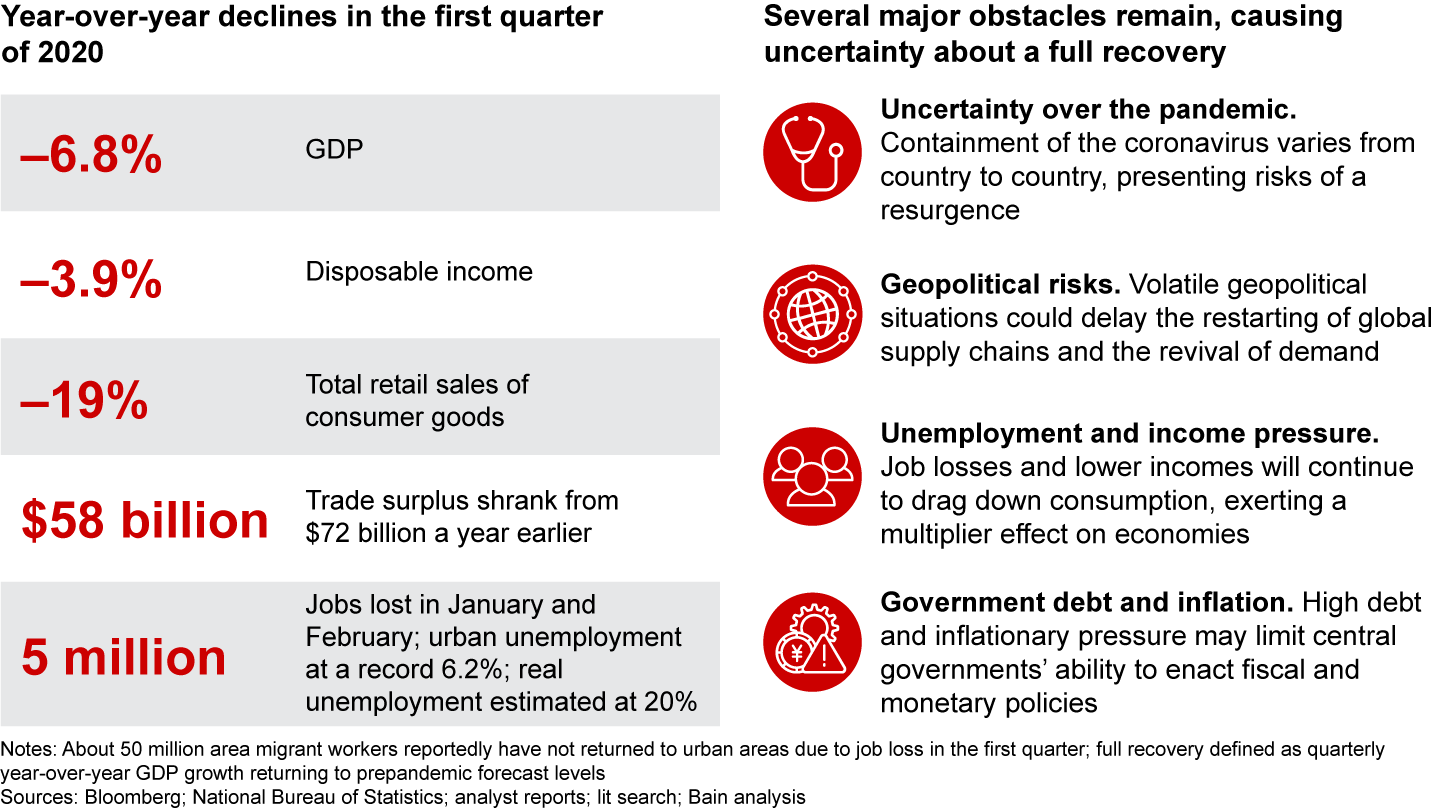

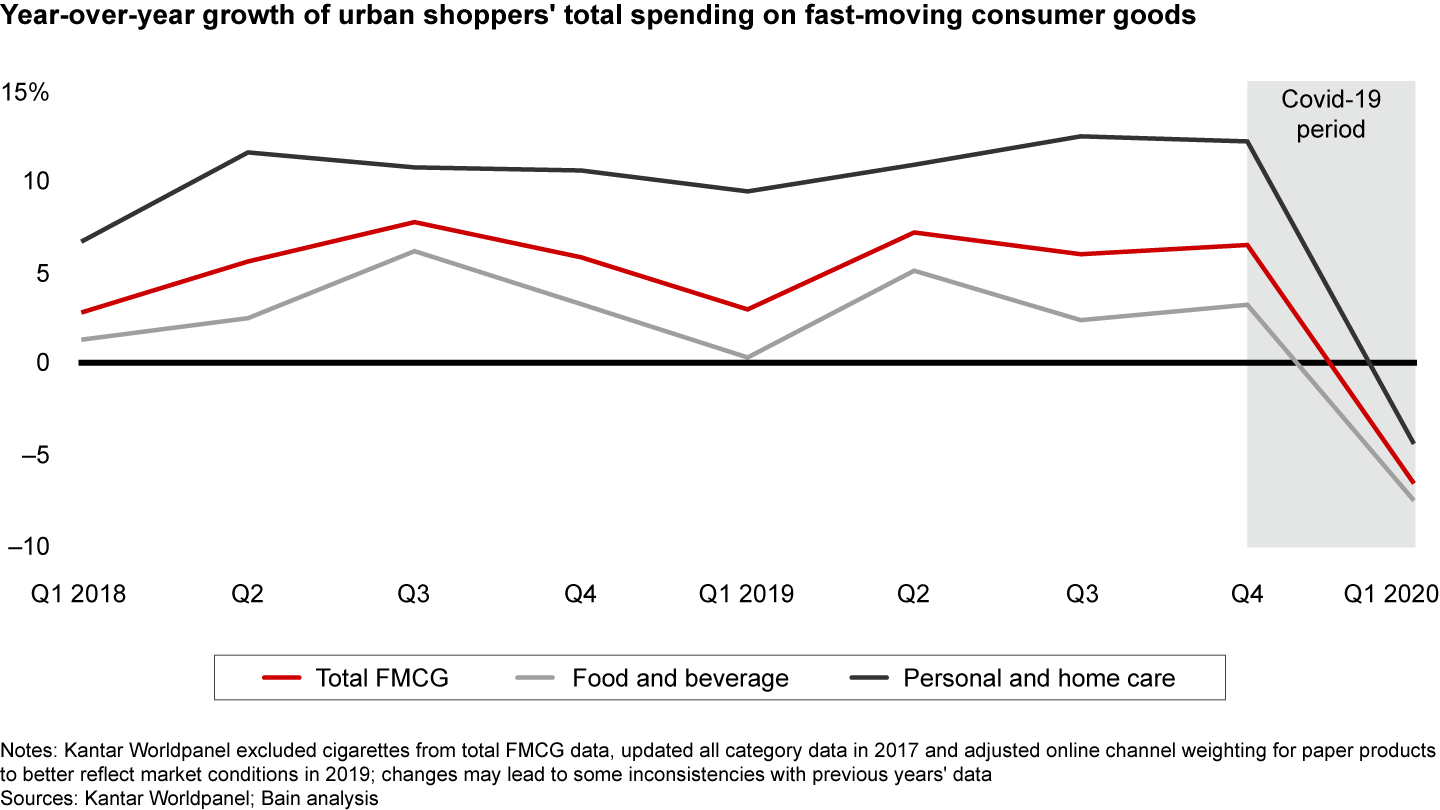

Different categories took distinct paths during Covid-19 and beyond. Health- and hygiene-related categories boomed and continue to boom, while nonnecessary and impulse-driven categories suffered during the outbreak and are recovering slowly.
Covid-19 affected FMCG companies in four distinct ways (see Figure 15). A first group of categories surged during the pandemic and continued booming in the recovery. This is the growth trajectory of hygiene categories such as personal wash and of other products that were widely used in stay-at-home situations. People spent more time cooking at home, so they bought more soy sauce, for example. Sales of these products remained strong as restrictions lifted, with consumers’ renewed commitment to their health and a continuing interest in cooking.
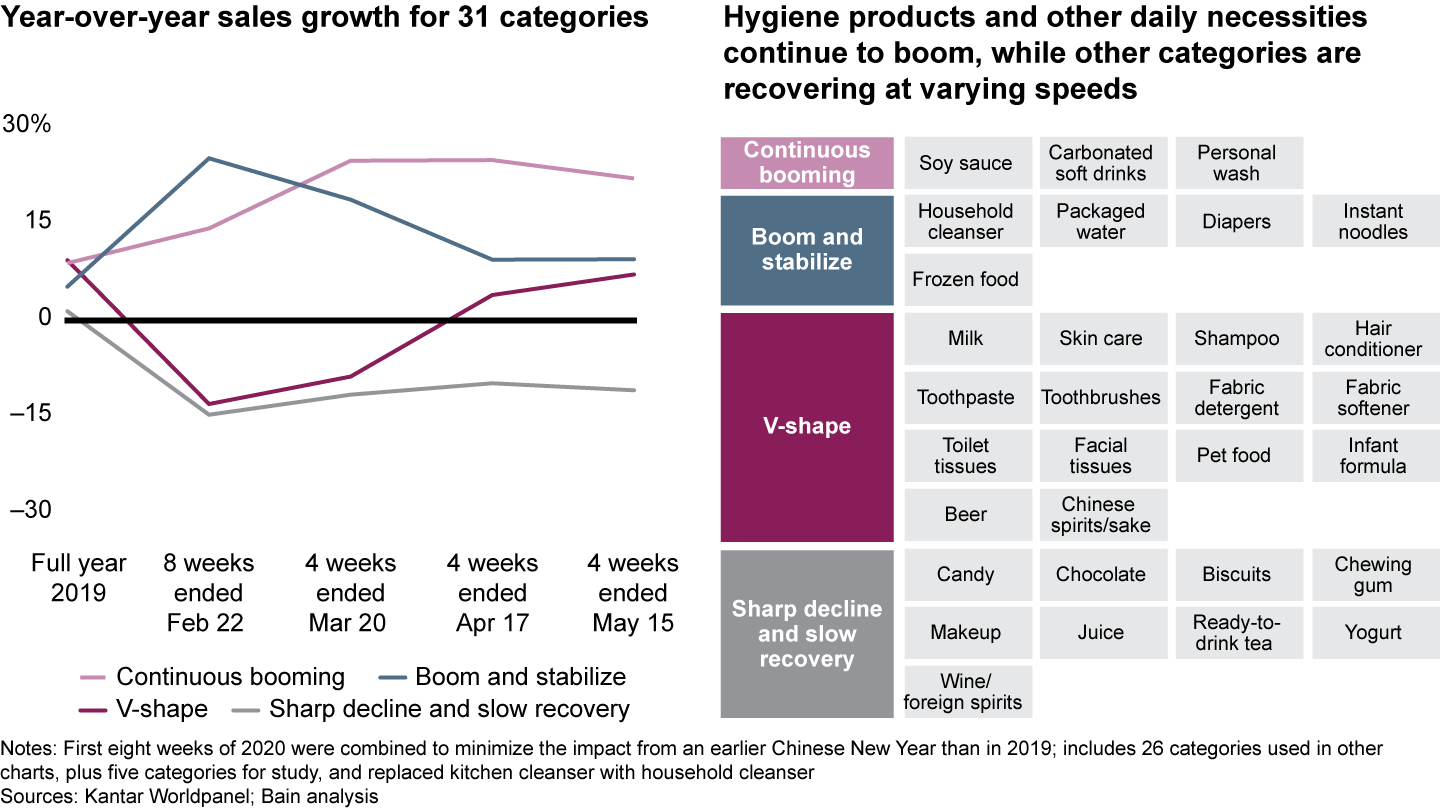

A second group of categories boomed in the lockdown weeks, but then stabilized. Consumers who stocked up on such categories as frozen food, packaged water and household cleanser did not need to buy more as restrictions lifted. A third group of categories such as beer, skin care and pet food went through a V-shaped recovery. Sales dropped dramatically during the pandemic, only to quickly recover as consumers repurchased the products. A final pattern: categories such as makeup, which is not essential for consumers wearing masks, and impulse categories such as candy declined, but are likely to slowly improve in an L- or U-shaped recovery.
First-quarter spending in 2020 shows how consumer behavior changed. Top brands and Chinese brands suffered less as consumers showed a preference for trusted and locally relevant brands. While sales for the top 5 brands dropped 6% in the first quarter of 2020 compared with the same period in 2019, all other brands suffered much worse, with 11% losses (see Figure 16). Similarly, local brands endured a 4% loss, compared with 14% for foreign brands, as consumers clung to the more familiar in the crisis. And there was a serious shift to nonpremium goods, which lost only 1% vs. the 12% for premium goods. The pandemic hastened the flight to value brands that we identified in 2019.
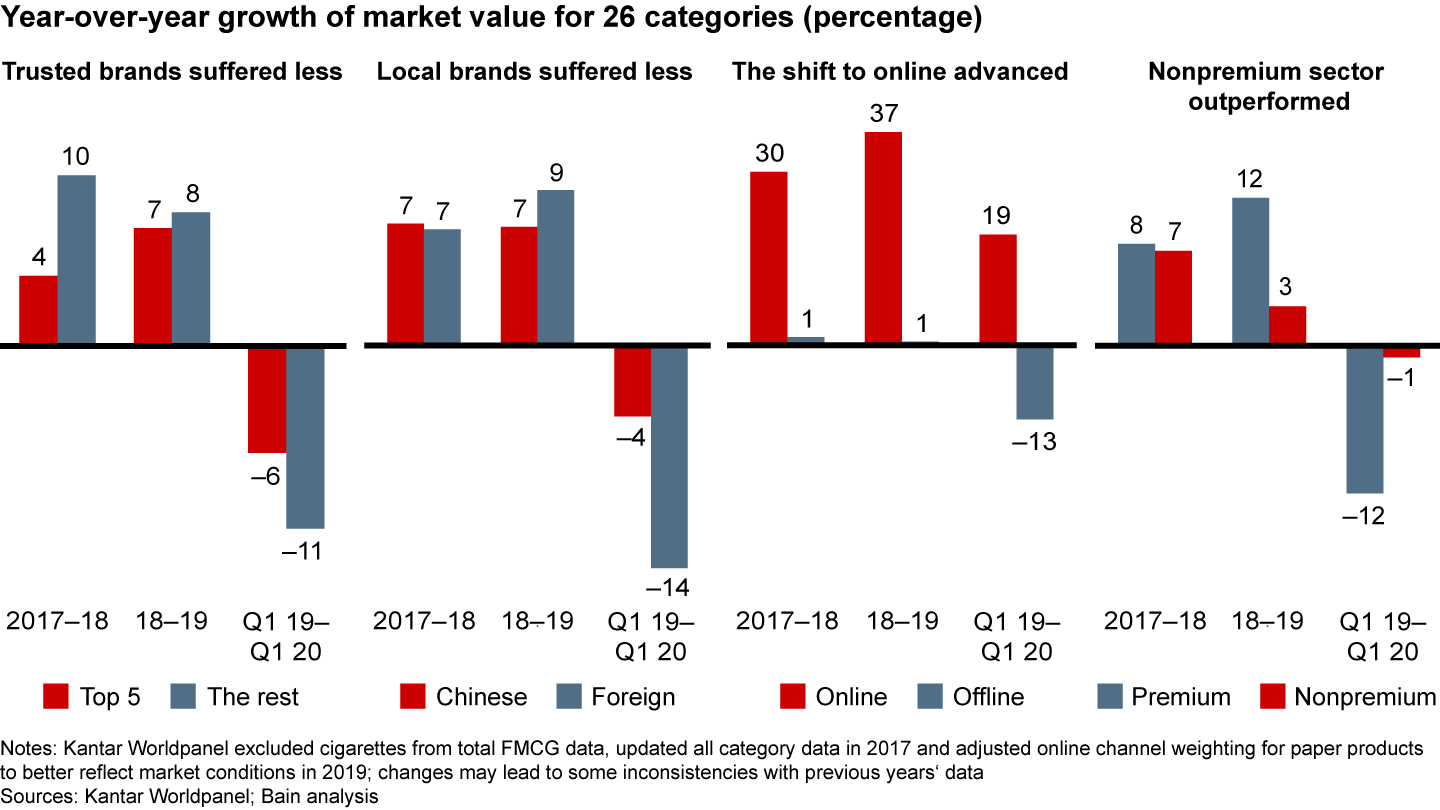

Another consequence: an acceleration of the shift to online channels. Quarantined consumers bought online—and many stuck with online purchases even after stores reopened. This was particularly true for grocery sales. Overall, online channels enjoyed a healthy 19% year-over-year growth in the first quarter of 2020, during the Covid-19 pandemic, while offline sales dropped by 13%.
What’s next? The country must deal with geopolitical risks, heightened unemployment, high levels of government debt and inflationary pressure. Amid so much uncertainty, economists vary widely in their predictions for the future, with some anticipating a year or more for the economy to recover fully.
Company leadership teams need to devote more time to planning for recovery and retooling. They need to explore how to adapt their value proposition, their capabilities and their ways of working to the new realities of the market, developing scenarios of what these new realities are likely to be. After the initial recovery phase, the most resilient and adaptable retailers are likely to rebound faster. They will have gauged how demand has changed, using that knowledge to reshape their appeal to consumers. As brands and retailers brace for whatever lies ahead, retooling will require corporate transformation as well as a renewed commitment to consumer understanding.
Implications for brands and retailers
Facing an uncertain future, brands can prepare by taking the following proactive steps.
- Closely monitor and reevaluate market, industry and consumer spending patterns in the post-Covid-19 economy to build a product portfolio with the right value propositions and pricing. That means appealing to changing consumer behaviors and emerging consumption occasions by offering and promoting relevant products (e.g., health and hygiene, wellness, home cooking).
- Cover both premium and value segments.
- Review the brand’s innovation pipeline to accelerate new products that are relevant post-Covid-19. For example, Unilever’s new disinfectant brand Botanical Hygiene was launched in February 2020, one month earlier than planned, to meet Covid-19 market demand.
- Win with winning channels, in particular online, O2O and livestreaming.
- Continue to build trust and local relevance with China’s consumers, even during uncertain times, with the 4D approach: design for China, decide in China, deliver at China speed and digitalize the China business
The post-Covid-19 world requires retailers to stay closer than ever to consumer trends and to focus operations on the areas that will matter the most.
To enhance consumer centricity:
- Win with fresh food offerings; it is more important than ever as consumers strengthen their commitment to health and wellness.
- Fast-forward e-commerce operations at scale and embrace O2O channels to serve consumers’ fragmented emerging needs for anywhere, anytime shopping.
- Thoughtfully curate product assortments, focusing on productive items and new items that consumers prefer after Covid-19.
To improve operations:
- Rapidly evolve store design and product portfolios to facilitate flexible fulfillment.
- Reduce complexity and establish a new cost baseline while protecting key consumer touchpoints.
- Infuse resilience into day-to-day operations by developing the ability to respond in real time to changes in demand and the workforce.
- Make omnichannel profitable to balance the increase in O2O participation in the business.
About the authors and acknowledgments
Bruno Lannes is a partner with Bain & Company’s Consumer Products and Retail practices, and is based in Shanghai. You can contact him by email at bruno.lannes@bain.com.
Derek Deng is a partner who leads Bain & Company’s Consumer Products practice in Greater China, and is based in Shanghai. You can contact him by email at derek.deng@bain.com.
Marcy Kou is CEO at Kantar Worldpanel Asia. You can contact her by email at marcy.kou@kantar.com.
Jason Yu is managing director at Kantar Worldpanel Greater China. You can contact him by email at jason.yu@ctrchina.cn.
This report is a joint effort between Bain & Company and Kantar Worldpanel. The authors extend gratitude to all who contributed to it, especially Chris Miao, Cindy Zhang and Caroline Wang from Bain, and Tina Qin, Robin Qiao and Lorna Peng from Kantar Worldpanel.
Kantar—Understand People, Inspire Growth
Kantar is one of the world’s leading evidence-based insights and consulting companies. Kantar has a complete, unique and rounded understanding of how people think, feel and act, globally and locally in over 90 markets. By combining the deep expertise of Kantar’s people with its data resources, benchmarks, innovative analytics and technology, Kantar helps clients understand people and inspire growth.
In the China market, the Worldpanel division is one of the services in CTR.

Coronavirus
The global Covid-19 pandemic has extracted a terrible human toll and spurred sweeping changes in the world economy. Across industries, executives have begun reassessing their strategies and repositioning their companies to thrive now and in the world beyond coronavirus.
Notes
- These 26 categories are (a) packaged food: biscuits, chocolate, instant noodles, candy, chewing gum and infant formula; (b) beverages: milk, yogurt, juice, beer, ready-to-drink (RTD) tea, carbonated soft drinks (CSD) and packaged water; (c) personal care: skin care, shampoo, personal wash, toothpaste, makeup, hair conditioner, diapers and toothbrushes; and (d) home care: toilet tissue, fabric detergent, facial tissue, kitchen cleanser and fabric softener.
- These 19 categories are soybean milk, mouthwash, oyster sauce, pet food, kitchen rolls, RTD coffee, hair colorant, quick soup, functional drinks, sesame sauce, hamburger, monosodium glutamate, soft cake, foreign spirits, leather care products, napkins, Chinese spirits, cooking oil and nutrient supplements.